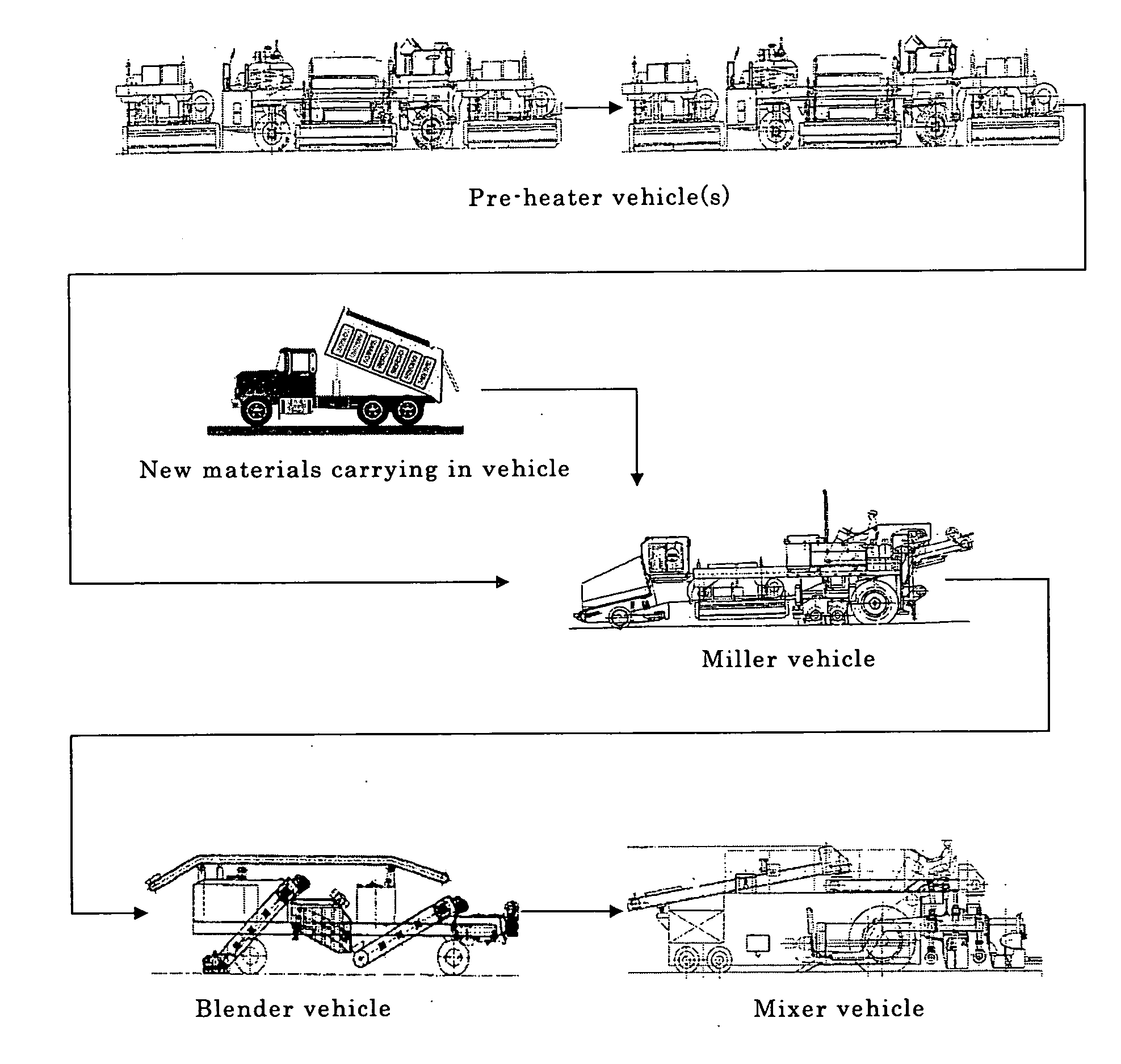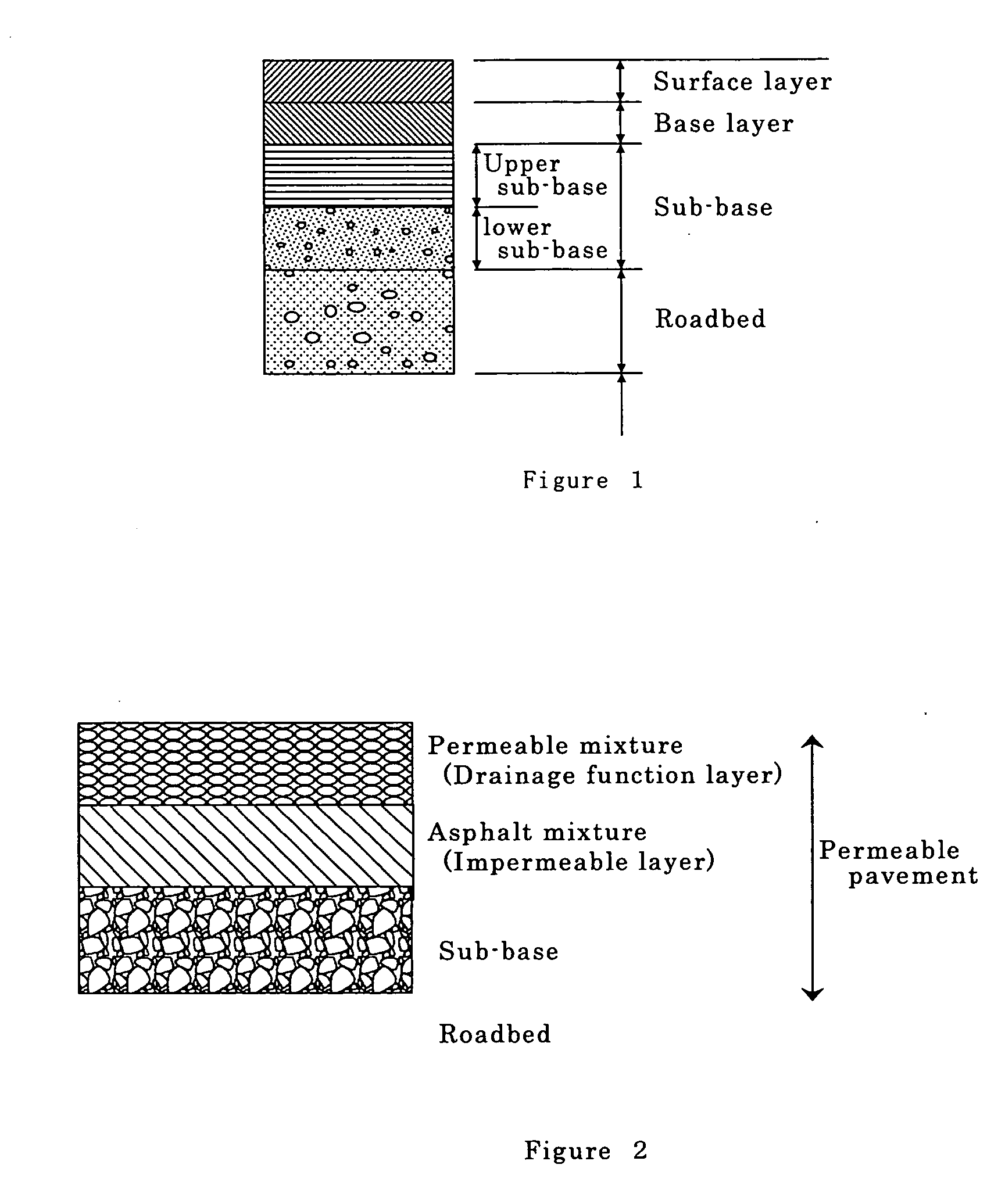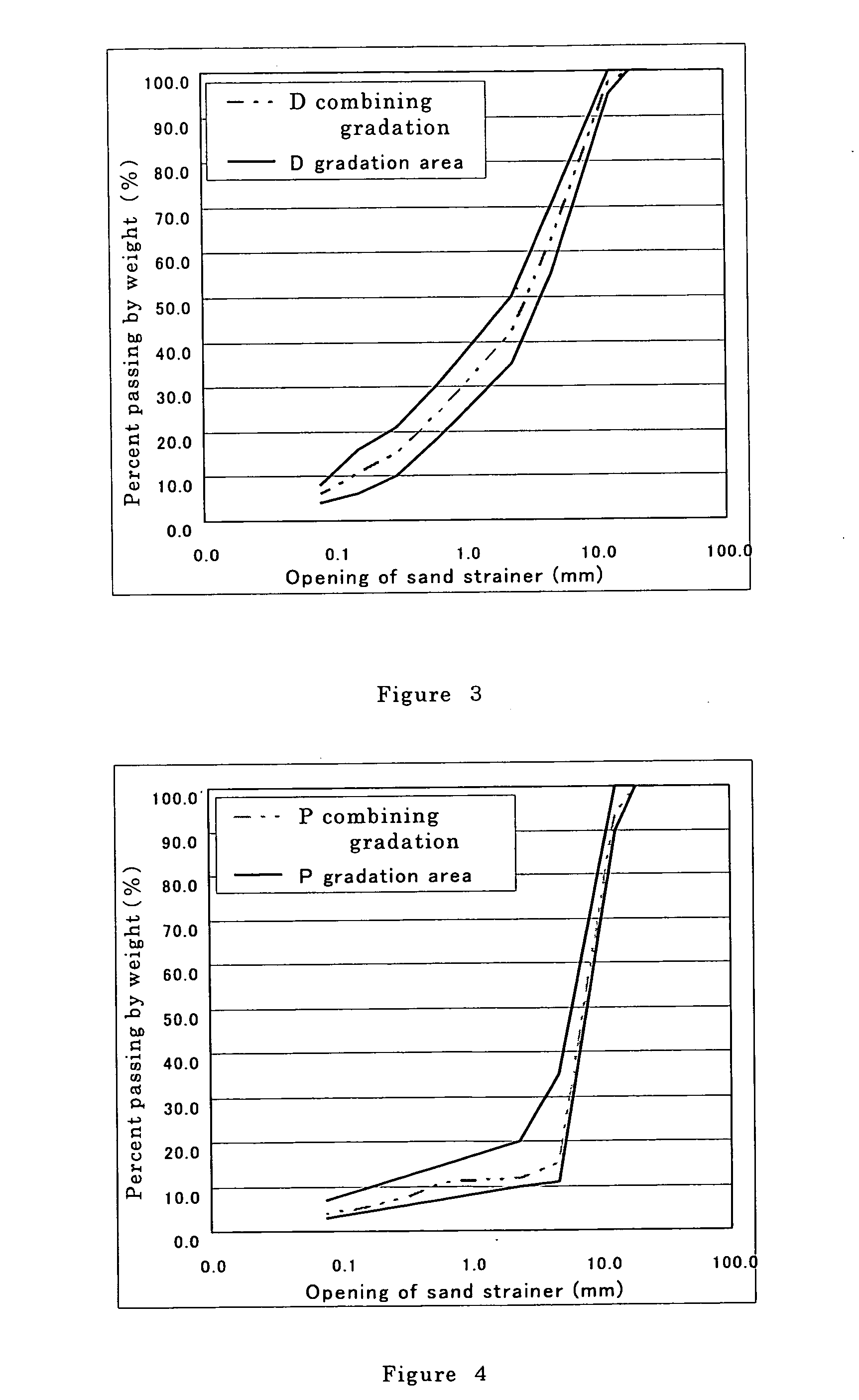It should be noted however that a water permeable pavement allows water to pass to the roadbed possibly resulting in an
adverse effect even the roadbed is caused to be weakened, so that such a water permeable pavement has not usually been adopted for the pavement of a
heavy traffic road but has generally been adopted for pavements in side-walks or relatively light traffic roads.
Meanwhile, it has been known that paved roads which are subjected to
heavy traffic due to busy
vehicle transportation have problems of
road surface deformation due to a
road surface wear caused by being subjected to serious weather conditions for a prolonged time or due to a so-called “rutting” phenomenon, as well as road
cracking due to deterioration, with the result that traffic safety is disturbed because rain water or thaw water may be trapped on the road surface causing a water splash or hydroplaning phenomenon, so that such road needs to be renewing of pavement through a repair work such as an asphalt repaving or patching.
So far, although an asphalt mixture layer of typical three-layer construction pavement has been described, as stated above, an asphalt mixture layer comprising road pavement, for a prolonged time, has problems of road
surface deformation such as so-called “rutting” phenomenon due to road surface wear caused by being subjected to busy
vehicle transportation and due to
fluidization of the asphalt mixture layer due to
softening of asphalt (binder) in accordance with a rising of an ambient temperature caused by being subjected to serious weather conditions, as well as road
cracking due to deterioration.
Furthermore, aggregates mixed in the asphalt mixture layer may be subjected to abrasion and breakage.
From an efficiency point of view, it is difficult to incorporate such blending step into a continuous on-site recycling process of an asphalt mixture layer of a pavement, so that the blending step is generally carried out as an off-line process wherein fixed or mobile plants are utilized to produce regenerated materials of asphalt mixture having predetermined specifications which are then transported back to the worksite.
Although the
plant regeneration pavement process has been established as a process for ensuring predetermined specifications, it is evident that technical and social issues caused by a loss of efficiency of application and disruption of traffic due to of the transportation from and to the worksite by construction vehicles due to the facts that the old materials must be carried back and forth between a
plant and a worksite with the method.
In the known methods, therefore, there have been no idea of restoring regenerated aggregates to be used as raw materials on the road, and blending the regenerated aggregates to reuse them on the road.
Furthermore, known construction methods are not able to assure particle size distributions as described in FIG. 3 and FIG. 4, because a sequence of construction steps on the road are not based on screening aggregates included in an existing asphalt mixture to classify into multiple particle size distributions by a screening device or the like, and measuring them by a measuring device, and then blending them by a blending device to produce regenerated materials of asphalt mixture.
In other words, it is impossible to assure a variety of predetermined performances completely because their steps are not incorporated into the sequence of construction steps.
However, a variety of predetermined specifications can not be ensured with even this system which operates similarly to known construction methods.
Although a variety of construction methods relating to recycling of asphalt mixture (old materials) on the road have been suggested other than those described above including component technology, anyone of these methods is also unable to ensure a variety of predetermined performances completely, because they are not based on incorporating steps of screening aggregates in different
diameter mixed into materials of asphalt mixture (old materials) to classify into multiple particle size distributions, measure them, and blending the particles of aggregate included in the materials of asphalt mixture as regenerated materials, into a sequence of construction steps on the road.
Because any known on-site recycling pavement construction methods of an existing pavement including a step of performing a recycling
plant process of materials of asphalt mixture (old materials) therein, require additional steps of process for transporting the old materials and the regenerated materials of asphalt mixture to and from between a recycling plant and a worksite as described above, it is difficult to avoid increasing green house gasses due to incoming and outgoing vehicles and due to traffic
jams caused by road closure for prolonged time, and also prolonging of construction term and increasing of construction cost in accordance with reduction of construction efficiency.
Furthermore, it is possible to take place insufficient compaction,
low density and decreased
adhesive force with aggregates caused by decreasing a temperature of materials of asphalt mixture until their arrival to a worksite because a recycling plant is usually located away from the worksite when a renewed asphalt mixture layer has been produced.
However, a system has not been developed so far to enable one to apply heat to the asphalt mixture layer to be softened, scarify and loosen materials of thus softened asphalt mixture layer to divide the materials into particles under a temperature wherein re-aggregation of the loosened particulate materials can be prevented to thereby provide particles of the divided materials of the asphalt mixture, screen the particles of the divided materials of the asphalt mixture to classify into a plurality of groups of different particle size distributions in accordance with particle sizes, blend continuously particles of different particle sizes in the plurality of groups to provide a regenerated asphalt mixture which meets predetermined specifications or performances on the road as carrying out in a recycling plant, mix uniformly the regenerated asphalt mixture, and then spread and compact the uniformly mixed, regenerated asphalt mixture over the road surface to provide a renewed asphalt mixture layer over the road surface.
So far, it is impossible to alter the functions or aspect of the asphalt mixture layer by incorporating the modification of
particle size distribution comprising aggregates into a sequence of known on-site construction steps, with the result that such
particle size distribution comprising aggregates have not been able to be converted into raw materials for recycling by reprocessing materials of asphalt mixture at a worksite in the prior arts.
In other words, it is obvious that an open graded, water permeable asphalt mixture layer cannot be formed continuously on the road by reusing raw materials regenerated from an existing dense graded, water impermeable asphalt mixture layer at a worksite in the prior arts.
More particularly, there has been no idea related to incorporating a reprocess capable of blending
particle size distribution comprising aggregates included in an existing asphalt mixture layer into a sequence of construction steps.
More particularly, this is not a vehicle which is able to apply heat to old materials of an existing asphalt mixture layer to be soften, scarify and loosen the old materials to divide the old materials into particles of aggregate under a temperature wherein re-aggregation of the scarified and loosened old materials can be prevented, to thereby provide particles of the divided old materials of the asphalt mixture, screen the particles of aggregate to classify into multiple particle size distributions to produce raw materials, incorporate a step of blending process for them into a sequence of construction steps on the road by measuring the weight thereof as a reprocessing in an asphalt recycling plant, and then form continuously a regenerated asphalt mixture layer of a pavement on the road.
 Login to View More
Login to View More  Login to View More
Login to View More 


